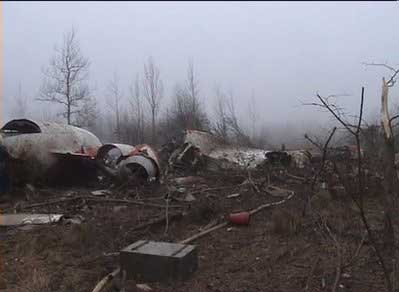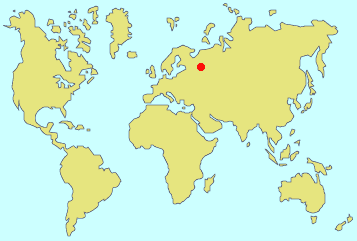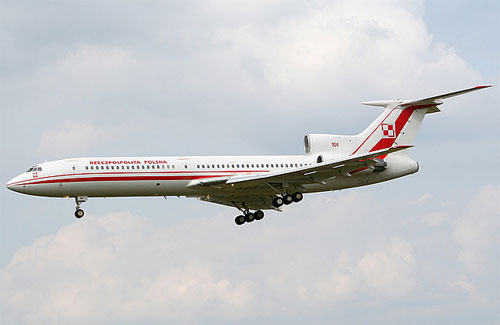Polish Air Force Tupolev TU-154M plane crash
Smolensk, Russia

Updated on
 The Tupolev 154M passenger jet, operated the Polish Air Force, took off from Warszawa, Poland, for a passenger flight bound to Smolensk, Russia. 88 passengers and 8 crewmembers were onboard, including the Polish President Lech Kaczynski. The plane was destroyed when it crashed on approach to Smolensk Airport in poor visibility. All the 96 people on board were killed.
The Tupolev 154M passenger jet, operated the Polish Air Force, took off from Warszawa, Poland, for a passenger flight bound to Smolensk, Russia. 88 passengers and 8 crewmembers were onboard, including the Polish President Lech Kaczynski. The plane was destroyed when it crashed on approach to Smolensk Airport in poor visibility. All the 96 people on board were killed.
Weather conditions at Smolensk were reportedly poor, with heavy fog. The airplane was on its first approach, when he was advised by Air Traffic Controller of a very poor visibility of 400 meters due to fog and recommended to divert to another airport, but the crew however responded that they would give it one try and divert thereafter if they were not able to land. The final approach was flown on autopilot and autothrust.
18 seconds prior to impact with the first obstacle the terrain avoidance warning system warned the crew of the risk a collision with the terrain. 5 seconds prior to impact with first obstacles the decision was made to go around and the autopilot was disconnected. The airplane first impacted a barrier 40 meters (130 ft) left of the extended centerline of the runway and 1100 meters (3500 ft) before the threshold of the runway. At this distance the tri-jet should have been at a height of 60 meters (200 ft), the standard for a 3° glideslope. The third impact with an obstacle, an 8m-tall birch tree of 30-40cm trunk diameter contacted by the left hand wing, 840 meters (2700 ft) before the runway threshold and about 80 meters (260 ft) left of the extended runway centerline, led to the first break up of the aircraft in flight, the aircraft rolled inverted and impacted ground 5 seconds later. The airplane came to rest about 350-500 meters (1150–1600 ft) short of the runway threshold and about 150 meters (500 ft) left of the extended runway centreline. Impact forces were estimated in excess of 100G and were not survivable.
Investigators noted the unusual crew interaction performed during this flight, due to the introduction of a navigator among the crewmember. No procedures were available for that type of crew combination and interaction, as the airplane is usually flown with a 3-man cockpit (captain, first officer, and engineer) and all training, documentation and manuals were set up only for a crew of three.
The cockpit voice recorder also revealed that persons not belonging to the flight crew were on the flight deck about 20 minutes prior to impact.
Rescuers that arrived on the crash scenes saw pieces of the plane scattered widely amid leafless trees and small fires burning in woods shrouded with fog. A tail fin with the red and white national colors of Poland stuck up from the debris.
Three flights were to land at the Air Base in that period of time: the first was a Yakovlev YAK-40 carrying journalists accompanying Poland's president, which made a safe landing. The second was a Russian Ilyushin IL-76, which diverted after two unsuccessful approaches. The third was the presidential Tupolev TU-154M.
Polish Aviation Accident Investigation Commission have released in July 2011 their final report. It concludes that the immediate cause of the accident was the descent below the minimum descent altitude at an excessive rate of descent in weather conditions which prevented visual contact with the ground, as well as a delayed execution of the go-around procedure. Those circumstances led to an impact on a terrain obstacle resulting in separation of a part of the left wing with aileron and consequently to the loss of aircraft control and eventual ground impact.
Circumstances contributing to the accident were:
- Failure to monitor altitude by means of a pressure altimeter during a non-precision approach;
- Failure by the crew to respond to the PULL UP warning generated by the TAWS;
- Attempt to execute the go-around maneuver under the control of ABSU (automatic go-around);
- Approach Control confirming to the crew the correct position of the airplane in relation to the RWY threshold, glide slope, and course which might have affirmed the crew's belief that the approach was proceeding correctly although the airplane was actually outside the permissible deviation margin;
- Failure by LZC to inform the crew about descending below the glide slope and delayed issuance of the level-out command;
- Incorrect training of the Tu-154M flight crews in the 36 Regiment.
- Incorrect coordination of the crew's work, which placed an excessive burden on the aircraft commander in the final phase of the flight;
- Insufficient flight preparation of the crew;
- The crew‘s insufficient knowledge of the airplane's systems and their limitations;
- Inadequate cross-monitoring among the crew members and failure to respond to the mistakes committed;
- Crew composition inadequate for the task;
- Ineffective immediate supervision of the 36 Regiment's flight training process by the Air Force Command;
- Failure by the 36 Regiment to develop procedures governing the crew's actions in the event of failure to meet the established approach criteria, using radio altimeter for establishing alarm altitude values for various types of approach, and distribution of duties in a multi-crew flight;
- Sporadic performance of flight support duties by LZC over the last 12 months, in particular under difficult weather conditions, and lack of practical experience as LZC at the SMOLENSK NORTH airfield.



